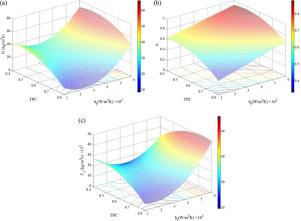Chemical Engineering Research and Design ( IF 3.7 ) Pub Date : 2020-05-26 , DOI: 10.1016/j.cherd.2020.05.018 Dongjian Cheng , Na Li , Hongcun Bai , Jianhua Zhang , Ziheng Wang , Feixiang Zeng , Jiawei Sun , Zongli Xie

|
Membrane distillation (MD) traditionally utilizes low-grade thermal energy to drive vapor transport through hydrophobic membrane pores for water treatment. The concurrent enhancement of water flux, thermal efficiency and water productivity to achieve the global optimization of MD is still a challenge. In this work, a new simulation and optimization approach is proposed by integrating theoretical heat and mass transfer models with response surface methodology to investigate the complicate interaction effects of various influencing factors on heat and mass transfer parameters, including overall mass transfer coefficient, feed/permeate side heat transfer coefficients, membrane surface temperature and temperature polarization coefficient, in direct contact membrane distillation (DCMD). The operating and module configuration variables show important interaction effects on enhancing the heat and mass transfer in the membrane module. The significantly elevated heat transfer coefficient on account of the combined high feed temperature, short module length and high feed velocity leads to a great improvement of water flux and thermal efficiency. The ultimate global optimum conditions for the high water productivity were determined where the high levels of heat transfer coefficient (5905 W/(m2·K)), temperature polarization coefficient (0.66), water flux (63.0 kg/(m2·h)) and thermal efficiency (0.83) all synchronously approach to their own pinnacles. The results indicate that it is an effective way to take advantages of the interaction effects of operating conditions with module configuration parameters to achieve the overall enhancement of MD performance.
中文翻译:

响应面法集成建模模拟直接接触膜蒸馏传热传质及多目标优化
膜蒸馏(MD)传统上利用低级热能来驱动蒸汽通过疏水性膜孔进行水处理。同时提高水通量,热效率和水生产率以实现MD的全球优化仍然是一个挑战。在这项工作中,通过将理论的传热和传质模型与响应面方法相结合,提出了一种新的模拟和优化方法,以研究各种影响因素对传热和传质参数(包括总传质系数,进料/渗透物)的复杂相互作用的影响。直接接触式膜蒸馏(DCMD)中的侧传热系数,膜表面温度和温度极化系数。操作和模块配置变量显示出对增强膜模块中热量和质量传递的重要相互作用。由于较高的进料温度,较短的组件长度和较高的进料速度,显着提高了传热系数,从而大大改善了水通量和热效率。在高传热系数(5905 W /(m2 ·K)),温度极化系数(0.66),水通量(63.0 kg /(m 2 ·h))和热效率(0.83)都同步接近自己的顶峰。结果表明,这是一种利用操作条件与模块配置参数的交互作用来实现MD性能的整体增强的有效方法。











































 京公网安备 11010802027423号
京公网安备 11010802027423号